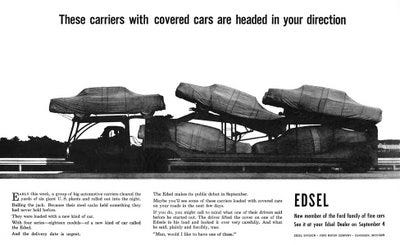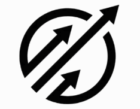There are few names in the industry that create an immediate and lasting image of failure. Edsel is one of them.
This 1958 Ford was supposed to be a breakout success. It was planned to be the car every middle-class American would want. As you’ll see, Ford had every chance to get the product right. But wrong move after wrong move cratered their plans.
Overfunded & overconfident
In today’s venture-backed world, massive funding signals a winning company. But loads of cash is no guarantee of success. In fact, it can often lead to a company’s demise. When it appears there is no end to the money teams often run fast and loose with terrible outcomes.
CB Insights has a list of over 150 of the highest funded failures. At the top of the list is Solyndra who pulled in $1.2B to develop solar panels. Jawbone raised $930M only to taste success and ultimately fail with every product. Then there is Theranos, a $724M flop and fraud.
A lot of people lost a lot of money with these failures. But the Edsel eclipses all of these…combined!
By the time it was over, Ford had lost 350 million dollars. Remember, this was 1958. In today’s dollars, that would be 3.2 billion dollars! All for a car that was only on the market for two years.
Ford believed they were starting a revolution. As you’ll see this overconfidence was an undertone of every decision and a definite part of the product’s demise.
Apple-esque
Intrigue. Secrecy. Hype. The Edsel marketing team had it all. If it were the 2000’s people would be comparing this effort to Apple.
“The Edsel is Coming” was Ford’s rallying cry. It drove consumer’s curiosity partly because they never showed the car. This effort was all to prime the market for “E-day,” the official unveiling of the car at dealers across the country.
As the days went on, customer’s would get glimpses of the vehicle, helping to further fuel interest. But this is where the comparisons to Apple end.

We all know that when people line up at their local Apple store to get the newest iPhone or Mac, they walk out bag in hand and grin on their face.
When people lined up to see Ford’s new wonder they left without buying and with a look of confusion.
There is no question that Ford nailed the marketing. Unfortunately, the rest of the company couldn’t deliver on the promise of the product.
Lack of focus and understanding of the customer
Ford was determined to make the Edsel the perfect car. They wanted the young buyers. They also wanted the middle-aged dads. They tried to sell the car to as many customers as possible and crush the competition. I have no problem with the aspiration, but their approach proved fatal.
They had to understand what buyers wanted to pull this off. After polling thousands of customers and completing tons of market research, they did the unthinkable. They filed it all away and ignored the data. Opting instead to make their own decisions about what the market needed.
Then came the next colossal mistake, most likely fueled by their previous missteps. The team decided to release 18 models of the car at launch! This approach was unheard of in the ’50s and would be insane today.
And they didn’t stop there. They sold the car with 68 additional options on top of the different models. There were also another 12 planned, but those never made it to market.
In an attempt to please everyone, Ford missed the mark for everyone.
To compound the problem, they made it impossible for manufacturing to deliver a quality product. Customers that did buy the Edsel enjoyed “oil leaks, sticking hoods, trunks that wouldn’t open, and push buttons that … couldn’t be budged with a hammer.”
Instead of cultivating raving fans, they had raging customers and one more nail in the coffin.
Timing and price
Ford was on a mission to develop a new luxury brand. Unfortunately, when the Edsel launched the economy went into recession and demand shifted to lower-priced models.
This market shift was an area Ford overlooked, Opting instead to release their most expensive models.
They weren’t the only victim of the recession. In fact, despite the Edsel, they survived. Luxury automakers DeSoto, Hudson, Nash, Packard, and Studebaker, weren’t so lucky.
That name
You can give Ford a pass for not predicting a recession. But they 100% own the failure of the name.
The process started as you would expect. Ford hired a top agency to develop the perfect moniker. The team came back with 18,000 names for the team to choose.
They needed to capture the essence of luxury, create a desire in the mind of the customer and build a brand that would get people talking.
Instead, they trashed every suggestion and christened the brand after Henry Ford’s first child. It wasn’t cool. It didn’t evoke any emotion. And eventually, the name became a laughing stock with customers using it as a comical abbreviation. “EDSEL — Every Day Something Else Leaks.” Ouch!
No chance to learn from the market
For Ford, failure wasn’t an option. They created a brand new division. A hugely expensive proposition. Then they passed on the burden to dealers, requiring them to pre-order a set number of cars before the Edsel rolled off the assembly line. Of course, by now we know how this turned out.
With the market in free fall and buyers staying at home, dealers were left holding the bag. Automotive News reported that “dealers in all makes were ending their season with the second-largest number of unsold cars in history.”
Ford didn’t have a way out. While they could have taken a more cautious approach and weathered the storm, they took this option off the table right from the start.
Too much ego
Perhaps the craziest part of this story is that the team that led the project never owned up to their mistakes.
J.C. Doyle, an Edsel manager, had this to say “What consumers had been buying for several years encouraged the industry to build exactly this kind of car. We gave it to them, and they wouldn’t take it. Well, they shouldn’t have acted like that. And now the public wants these little beetles. I don’t get it!”
He was referring to the new VW Beetle which was introduced around the same time and was a monster success. Low cost, unique design and fuel efficient, it was everything the market needed at that time.
Final thoughts
When you’re inside a bubble of buzz, it can be hard to acknowledge you don’t have all the answers. It’s hard to set aside ego. As product leaders, it’s our job to build the right product, for the right market, at the right time.
It’s no easy task, and there is no guarantee of success even if you take all the right steps. However, one thing is for sure. Ignore the data, your customers, the market and assume all the answers lie in the four walls of your company and you can guarantee one thing. Failure.
If you are looking for tools to help better understand your customers and how to discover breakout product ideas, please check out my new Udemy course. If you take it, I’d love to get your feedback.



